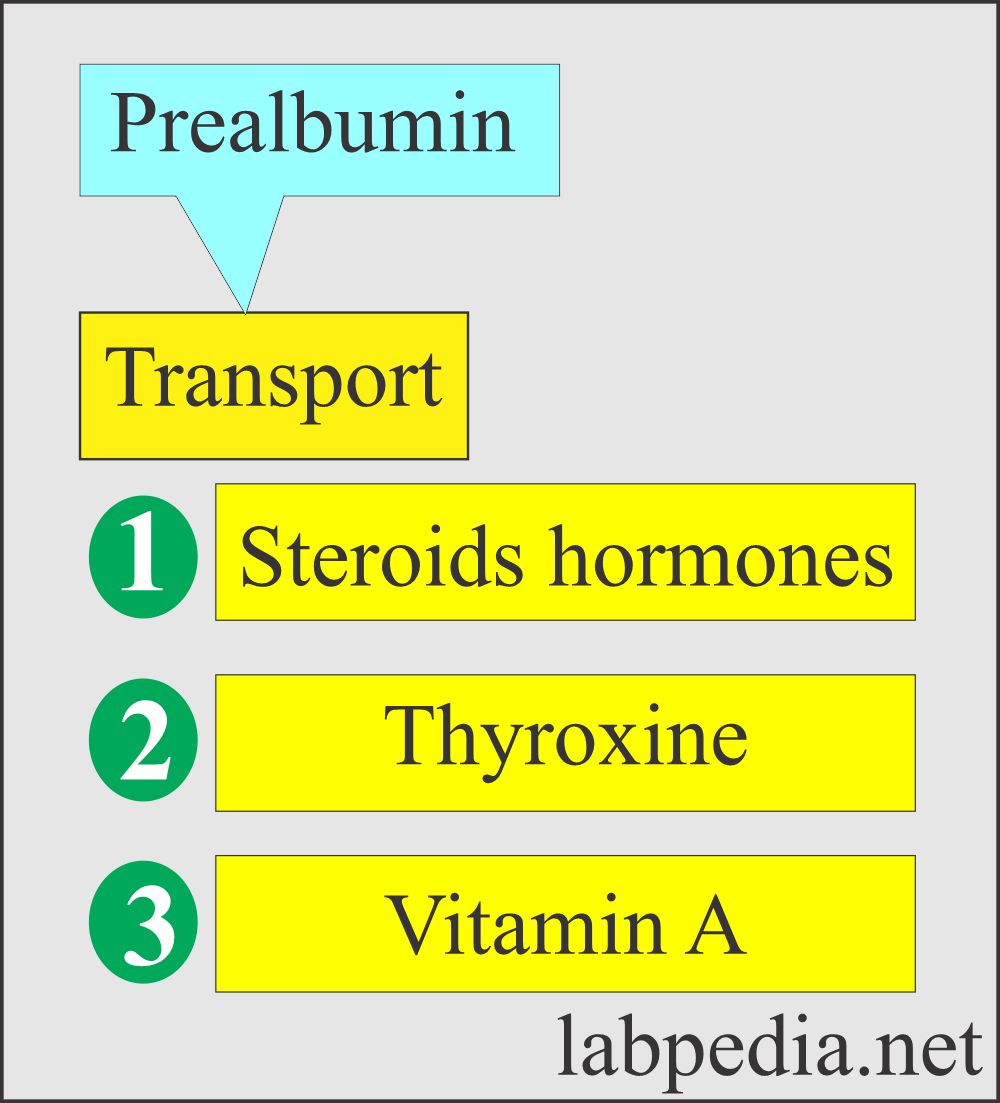Thyroxine-Binding Prealbumin (TBPA), Prealbumin
Thyroxine-binding prealbumin (TBPA)
What sample is needed Sample for Thyroxine-Binding Prealbumin (TBPA)
- The patient’s venous blood is needed to prepare the serum.
- This can be estimated in the 24 hours of urine and CSF.
What are the indications for Thyroxine-Binding Prealbumin (TBPA)?
- Marker for the patient with nutritional status.
- It is a sensitive indicator of protein synthesis and catabolism.
What are the precautions for Thyroxine-Binding Prealbumin (TBPA)?
- Avoid hemolysed and lipemic serum.
- In the case of coexistent infection, the results are not reliable.
- Anabolic steroids, androgens, and prednisone increase the level.
- Amiodarone, oral contraceptives, and estrogens decrease the level.
How will you define Thyroxine-Binding prealbumin?
- Thyroxine-binding prealbumin, also known as Transthyretin.
- It binds thyroxine and retinol and transports them in the blood and CSF.
- Thyroxine-binding prealbumin is a tetramer with a molecular weight of 50,000 D.
- It is made of identical subunits with 127 amino acids.
How will you discuss the pathophysiology of Thyroxine-Binding Prealbumin (TBPA) and Prealbumin?
- Prealbumin is the major plasma protein.
- Prealbumin has a shorter half-life of 2 days.
- The Prealbumin half-life of 2 days is much less than the albumin of 21 days.
- This is present in the serum and CSF.
- This is the main component of the CSF proteins.
- The pre-albumin binds:
- Retinol (RBP) also binds the vit. A.
- Prealbumin binds the thyroxin called thyroxine-binding prealbumin (TBPA).
- This is a better marker than albumin and transferrin.
- This is a better indicator of synthetic liver activity.
- Prealbumin levels fluctuate more rapidly in response to liver synthesis rate than the other proteins, so clinical quantitation of the prealbumin is more valuable as a marker of the nutritional status.
- Because of the shorter half-life, it is a better indicator of any change affecting protein synthesis and catabolism.
- This is advised to monitor the effectiveness of total parenteral nutrition.
- Prealbumin decreases acute and chronic inflammation.
- Prealbumin is a negative acute-phase reactant protein.
- Its level decreases in malignancy and inflammation.
- Also, it decreases the protein-losing disease of the intestine and kidneys.
- Zinc is needed for its synthesis, so if there is a zinc deficiency, prealbumin will be below.
What is the normal value of prealbumin and Tranthyretin?
Thyroxine-binding prealbumin (Transthyretin)
- Normal on protein electrophoresis = 2% to 7%
- Prealbumin (Transthyretin)
- <6 weeks = 4 to 36 mg/dL
- >16 years = 13 to 27 mg/dL
- Adult = 19.5 to 35.8 mg/dL:
Prealbumin:
Source 2
- Adult = 15 to 36 mg/dL.
- Child:
- < 5 days =6 to 21 mg/dL
- 6 to 9 years = 15 to 33 mg/dL.
- 10 to 13 years = 22 to 36 mg/dL.
- 14 to 19 years = 22 to 45 mg/dL.
- Urine 24 hours = 0.017 to 0.047 mg/ 24 hours.
- CSF = 2% of the total CSF proteins.
What are the causes of decreased levels of prealbumin?
- In hepatocellular dysfunction.
- It is decreased in tissue damage.
- In inflammation.
- In malnutrition.
- In burn.
- Drugs like oral contraceptives, Estrogen, and amiodarone.
- Salicylates poisoning.
What are the causes of increased levels of prealbumin?
- In Hodgkin’s disease.
- In chronic kidney diseases.
- Some cases of nephrotic syndrome.
- In pregnancy
- Drugs like steroids, prednisolone, and androgens.
- Critical value = when <10.7 mg/dL
- This indicates severe nutritional deficiencies.
Questions and answers:
Question 1: What is the half-life of prealbumin?
Question 2: Why prealbumin is important?

